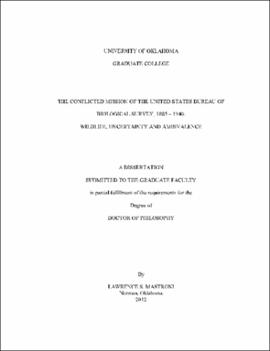| dc.description.abstract | The United States Bureau of Biological Survey, initially founded as the Division of Economic Ornithology and Mammalogy within the Department of Agriculture in 1885, began with a focus on scientific research. Its principle responsibilities were mapping the North American continent's geographical distribution of flora and fauna and determining which animal species were beneficial or injurious to agriculture. Soon, however, the Survey took on new assignments. By the first decade of the twentieth century, the federal bureau was controlling predators and rodents, protecting wildlife on big game reservations and avian refuges, and enforcing wildlife legislation. These added responsibilities resulted in a conflicted mission for the Survey: Since the bureau had to both kill (through predator and rodent control) and protect wildlife, it could not build unequivocal, long-lasting alliances with groups of constituents that would support the Survey. Stockmen supported predator and rodent control yet were critical of wildlife protection. Sport hunters welcomed the avian refuges but often opposed the enforcement of hunting regulations. Scientists and conservationists endorsed wildlife protection but disapproved of predator and rodent control. Furthermore, states, other federal agencies, and residents living near the refuges and reservations often had their own ideas about wildlife and the acceptable use of land designated for wildlife protection, sometimes welcoming the Survey, sometimes opposing it, and sometimes demonstrating a combination of support and resistance. Thus, the Survey's relationships with states, other bureaus, local citizens, and different groups of constituents were ambivalent and uncertain. The uncertainty was further exacerbated by the lack of basic knowledge of wildlife, a reflection of the incipient fields of wildlife science and game management. Working within the restraints of a conflicted mission, divided authority between state and federal government over the management of wildlife, a wavering base of support, and limited scientific understanding of wildlife, the Survey faced its responsibilities with a high degree of uncertainty and was pulled in multiple directions. | |
